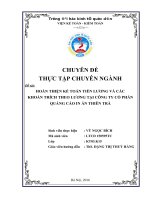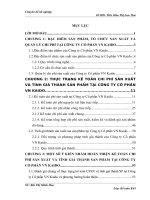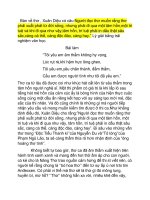a0126 oracle database 10g ocp certification all in one exam guid morebook vn 6482
Bạn đang xem bản rút gọn của tài liệu. Xem và tải ngay bản đầy đủ của tài liệu tại đây (267.13 KB, 7 trang )
All-in-1 / Oracle Database 10g OCP Certification All-in-One / Watson & Bersinic / 5790-3 /Chapter 1
blind folio: P
PART I
Oracle Database 10g
Administrative I Exam
■
■
■
■
■
■
■
■
■
■
■
■
■
■
■
■
■
■
■
■
■
ch01.indd 1
Chapter 1
Chapter 2
Chapter 3
Chapter 4
Chapter 5
Chapter 6
Chapter 7
Chapter 8
Chapter 9
Chapter 10
Chapter 11
Chapter 12
Chapter 13
Chapter 14
Chapter 15
Chapter 16
Chapter 17
Chapter 18
Chapter 19
Chapter 20
Chapter21
Basic Oracle Concepts
Installing Oracle Database 10g
Creating an Oracle Database
Interfacing with the Oracle Database
Managing Oracle Processes
Managing Oracle Storage Structures
Administering Users
Managing Database Objects
Manipulating Database Data
Programming Oracle with PL/SQL
Securing the Database
Configuring Oracle Networking
Managing Shared Servers
Managing Database Performance
Monitoring Oracle
Managing Undo
Dealing with Locking
Configuring the Database for Backup and Recovery
Backing Up Oracle Databases
Recovering Oracle Databases
Managing Globalization in Oracle Databases
6/17/2005 4:39:32 PM
All-in-1 / Oracle Database 10g Certification All-in-One / Meyers / 5790-3 / Chapter 23
blind folio: PB
ch01.indd 2
6/17/2005 4:39:57 PM
All-in-1 / Oracle
All-in-1
Database
/ Oracle10g
Database
OCP Certification
10g Certification
/ Watson
All-in-One
& Bersinic
/ Meyers
/ 5790-3
/ 5790-3
/Chapter
/ FM
1
blind folio: PB
CHAPTER 1
Basic Oracle Concepts
In this chapter you will learn
• What a database is and what makes a database relational
• What SQL is
• Which database objects are supported in Oracle 10g
• What a database administrator does
• How the Oracle database fits into the Oracle product family
3
ch01.indd 3
6/17/2005 4:39:58 PM
All-in-1 / Oracle Database 10g Certification All-in-One / Meyers / 5790-3 /Chapter 23
Oracle Database 10g OCP Certification All-in-One Exam Guide
4
Someone once said that the best place to start is at the beginning. With Oracle, that
means understanding where the idea of a relational database management system
(RDBMS) came from and what a database is—in computer and everyday terms. Even
though the material presented here may not be directly tested on the exam, this is
assumed knowledge, however, so a quick read is probably a good idea.
Introduction to Databases
and the Relational Model
In one form or another, databases have always been around, though their exact shape
was not always easily recognizable. As long as some form of data had to be stored,
there was always a method of storing it.
Databases, in their most simple form, are a mechanism for storing data. The data
can be logical, like the values stored in a computer program, or may be physical, like
a file or receipt. You probably have databases in existence all around you, but you
may not see them as such. For example, the shoebox in which you’ve placed your tax
receipts for the accountant is a database of your annual expenses. When you open a
file cabinet and take out a folder, you are accessing a database. The content of the file
folder is your data (e.g., your credit card statements, your bank statements, invoices,
purchase orders, etc.). The file cabinet and drawers are your data storage mechanisms.
Before the advent of computers, all data was stored in some easily recognizable
physical form. The introduction of computers simply changed the data from a physical
form that you can touch and feel to a digital form that is represented by a series of 1’s
and 0’s. Does the information that you display for an expense report on the computer
screen differ greatly from the same information in the hard-copy version of the expense
form? Perhaps the information is laid out differently than on the screen, but the key
elements—who was paid, what amount, how much was the tax, what was the purpose
of the expense, and so on—are all the same.
In looking at a database and its most basic set of characteristics, the following
points hold true:
• A database stores data. The storage of data can take a physical form, such as
a filing cabinet or a shoebox.
• Data is composed of logical units of information that have some form of
connection to each other. For example, a genealogical database stores
information on people as they are related to each other (parents, children, etc.).
• A database management system (DBMS) provides a method to easily retrieve,
add, modify, or remove data. This can be a series of filing cabinets that are
properly indexed, making it easy to find and change what you need, or a
computer program that performs the same function.
ch01.indd 4
6/17/2005 4:39:58 PM
All-in-1 / Oracle Database 10g OCP Certification All-in-One / Watson & Bersinic / 5790-3 /Chapter 1
PB
Chapter 1: Basic Oracle Concepts
5
PART I
When data began to move from a physical form to a logical form using computers,
different theoretical versions of systems to manage data evolved. Some of the more
common database management systems in use over the last 50 years include the
hierarchical, network, and relational. Oracle is a relational database management system
(RDBMS).
The Relational Model of Databases
The relational model for database management systems was proposed in the June
1970 issue of Communications of the ACM—the Association of Computing Machinery
journal—by Dr. E.F. Codd, an IBM researcher, in a paper called “A Relational Model
of Data for Large Shared Data Banks.” For its time it was a radical departure from
established principles because it stated that tables that have related data need not
know where the related information is physically stored. Unlike previous database
models, including the hierarchical and network models, which used the physical
location of a record to relate information between two sets of data, the relational
model stated that data in one table needed to know only the name of the other table
and the value on which it is related. It was not necessary for data in one table to keep
track of the physical storage location of the related information in another.
NOTE The full text of Dr. E.F. Codd’s paper “A Relational Model of Data for
Large Shared Data Banks” can be found in the classics section of the ACM
web site at www.acm.org/classics/nov95/toc.html.
The relational model broke all data down into collections of objects or relations
that store the actual data (i.e., tables). It also introduced a set of operators to act on
the related objects to produce other objects (i.e., join conditions to produce a new
result set). Finally, the model proposed that a set of elements should exist to ensure
data integrity so that the data would be consistent and accurate (i.e., constraints). Codd
proposed a set of twelve rules that would allow designers to determine if the database
management system satisfied the requirements of the relational model. Although no
database today satisfies all twelve rules (because the database would run very slowly if
it did, since theory is not always the same as practice), it is generally accepted that any
RDBMS should comply with most of them.
The essence of the relational model is that data is made up of a set of relations.
These relations are implemented as two-dimensional tables with rows and columns
as shown in Figure 1-1. In this example, the Customers table stores information about
clients we deal with—their customer ID, their company name, their address, and so on.
The Orders table stores information about the client orders (but not the order line
items—these are in another table), including the order data, the method of payment,
the order date, and the ship date. The CustomerID column in both tables provides the
relationship between the two tables and is the source of the relation. The tables
themselves are stored in a database that resides on a computer. The physical locations
of the tables need not be known—only their names.
ch01.indd 5
6/17/2005 4:39:58 PM
All-in-1 / Oracle Database 10g OCP Certification All-in-One / Watson, Bersinic / 5790-3
Glossary of Acronyms
7
RAID Redundant Array of Inexpensive Disks. Techniques for enhancing performance
and/or fault tolerance by using a volume manager to present a number of physical
disks to the operating system as a single logical disk.
RAM Random Access Memory. The chips that make up the real memory in your
computer hardware, as against the virtual memory presented to software by the
operating system.
RDBMS Relational Database Management System, often used interchangeably
with DBMS.
RMAN Recovery Manager. Oracle’s backup and recovery tool.
RVWR The Recovery Writer background process, an optional process responsible
for flushing the flashback buffer to the flashback logs.
SBT System Backup to Tape. An RMAN term for a tape device.
SCN System Change Number. The continually incrementing number used to track
the sequence and exact time of all events within a database.
SGA System Global Area. The block of shared memory that contains the memory
structures that make up an Oracle instance.
SID System Identifier. The name of an instance, which must be unique on the
computer the instance is running on. (2) Session Identifier. The number used to
identify uniquely a session logged on to an Oracle instance.
SMON The System Monitor. The background process responsible for opening
a database and monitoring the instance.
SQL Structured Query Language. An international standard language for extracting
data from and manipulating data in relational databases.
SSL Secure Sockets Layer. A standard for securing data transmission, using
encryption, checksumming, and digital certificates.
TCP Transmission Control Protocol. Together with the Internet Protocol, TCP/IP,
the de facto standard communication protocol used for client/server communication
over a network.
TCPS
TCP with SSL. The secure sockets version of TCP.
TNS Transparent Network Substrate. The heart of Oracle Net, a proprietary layered
protocol running on top of whatever underlying network transport protocol you choose
to use, probably TCP/IP.
UGA User Global Area. The part of the PGA that is stored in the SGA for sessions
running through shared servers.
glossary.indd 7
7/12/2005 9:54:15 AM
All-in-1 / Oracle Database 10g OCP Certification All-in-One / Watson, Bersinic / 5790-3
Oracle Database 10g OCP Certification All-in-One Exam Guide
8
UI User Interface. The layer of an application that communicates with end users,
nowadays frequently graphical: a GUI.
URL Uniform Resource Locator. A standard for specifying the location of an object
on the Internet, consisting of a protocol; a host name and domain; an IP port number;
a path and filename; and a series of parameters.
UTC Coordinated Universal Time, previously known as Greenwich Mean Time
(GMT). UTC is the global standard time zone; all others relate to it as offsets, ahead
or behind.
X As in X Window System, the standard GUI environment used on most computers,
except those that run Microsoft Windows.
XML Extensible Markup Language. A standard for data interchange using documents,
where the format of the data is defined by tags within the document.
glossary.indd 8
7/12/2005 9:54:15 AM









